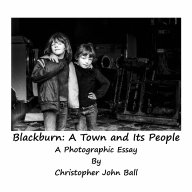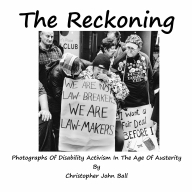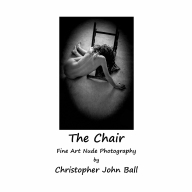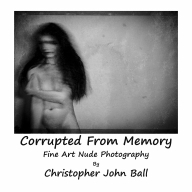
Practical Dreamer - The Photography of Nicolas Tucker By Christopher John Ball

Tweet
Born in 1948 British photographer Nicolas Tucker left his birthplace of Devon after leaving school – where he claims to have been “proficient at nothing at all” - to take up a place at the London College of Printing. Unfortunately, the government grant upon which he was intending to live on whilst studying at college, fell through. Instead Nic found himself learning his craft by taking up various posts assisting photographers in London – “some very nice, some monstrous, but all good experience, and then I worked for advertising, design companies and editorial.”
After assisting for nearly ten years, and becoming increasingly confident in his own abilities as a photographer, Nic decided that the late 1970’s were the right time for him to stop giving other photographers the benefits of his skills and go it alone – “it is much better doing work for yourself.” Over the years Nic has become a widely exhibited and published photographer in his own right. His work is in demand by a huge range of international clients including Vogue, Harpers and Queen and Tatler. In addition he has images held in permanent collections within the V&A – London, MOMA - New York, Biblioteque Nationale – Paris and Rhenischeslander Museum – Bonn and many others. His imagery has been exhibited internationally since 1978 in galleries as varied as Victoria and Albert Museum and Chelsea Arts Club in London, Royal Photographic Society in Bath, Centre de la Photographie in Geneva, and galleries in Mexico.
As an artist of some renown Nic is a welcomed regular at London’s The Colony Room Club - Soho's infamous 50 year old watering hole for artists of all descriptions. The Colony was once the favorite drinking establishment for the likes of Francis Bacon and Lucien Freud. Nowadays old school members such as Nic can be found alongside various BritArt celebrities - namely Damien Hirst, Marc Quinn, Tracey Emin, Sam Taylor Wood and Daniel Chadwick. Perhaps it is whilst socialising with other artists and celebrities at The Colony that Nic garners some of his inspiration along with the chance to practice his impish wit on an appreciative audience.
Nic states that he had to be careful with the composition of this image as he had only been able to get the model to pose topless. The pose she has adopted is again a throw back to another era. The objects on the mantelpiece offer up a still life within the image itself. The model is addressing the viewer directly. Nothing in this photograph is out of place. This is an image that would be very hard to improve upon aesthetically and displays the photographer’s strengths as an image maker. His photography covers many genres. The viewer can delight in his travel images of China, Chile, Spain, Vietnam, Cambodia, Hong Kong and St Petersburg. Look deep into his portraits of such faces as Ansel Adams, Aaron Siskind, Muhammed Ali, Victoria Abril and Bill Brandt or gaze longingly at his nudes and - whilst one can see the influence of Siskind, Friedlander, Man Ray, Callahan, Duane Michals and Edward Weston within the images - one can always detect the unique signature of the artist Nic Tucker at work. Whilst reference can be made to the aforementioned photographers the words of Lee Friedlander should be kept in mind “…the real difference between photographers is that they each lived in their times.”
Nic claims that the Man Ray book on the floor of this image was a coincidence and wasn’t intended and that the model had been simply been reading the book between shots. The image was made in a friend’s studio. It may well indeed have been no more than a happy accident but fate has a way of rewarding those individuals that are blessed with the ability to pre-visualise and the means to communicate that vision to others. The sinister claw-like shadow above her head looks like something out of F. W. Murnau’s 1922 silent epic ‘Nosferatu’ and seems set to strike silently at her breast. Indeed many of Nic’s photographs have the look of a film still. The pose adopted by the model hints at another time and contributes to the production of an image that seems to be a cross between Friedlander and Man Ray. As with many of Nic’s nude photographs - we half expect his models to turn out to be Lee Miller reincarnate.
Of course it is his hypnotic and witty images of the naked human form that are of particular interest to us. There are many impulses that draw an artist to this particular subject matter and the female nude is for Nic …“the most wondrous thing in the world.” When asked about his motivation for choosing this particular subject he playfully responds “You don’t need much of a reason when you’re taking girls clothes off. To be honest, of course, it’s voyeurism.” This reminds one of Man Ray’s response to the question why he often photographed the female nude “…I have always had a great fondness for this subject, both in my paintings and in my photos, and I must admit not for purely artistic reasons.” For Man Ray “…photographing the nude was the hardest work, in fact, the more beautiful the model the more difficult it is to make something that did her justice” - yet Man Ray made it look as if he actually found it rather easy to produce that “something” that would do her justice – a skill Nic shares. He playfully states that, for him “…nudes are a combination of the desire to see a girl naked and the problem of justifying that feeling with a picture that will please her and she can be pleased about for the rest of her life, actually one that you are pleased with is OK too.”
Reminiscent of the playful narrative poetry of photographer Duane Michals, with a knowing reference to the nude studies of Lee Friedlander, the composition within this image encourages the viewer to question the scopophilic nature of photography and the photographed. Where the viewer watches an enclosed world and can project their desires on to those being photographed. Here the woman sits naked on the staircase. At the bottom of the frame stands another individual. From the shoes we assume that he is male – possibly the photographer. Is she blocking the path of the man or do the stairs, and her position at their base, symbolise the route to be taken should he accept her ‘invitation’ – the journey having been made easier given that she has come down to meet him? The composition cuts off her eyes at the top of the frame thus we are denied her expression. The conventional reading would claim that the viewer is being encouraged to take her place and be her eyes. But, such is the complexity hidden within this apparently simple composition, another reading could have it that we are being challenged by the artist to accept that we, the viewers, are the ones holding the camera and hence guilty of the sin of objectification.
This image features a recurring theme within Nic’s photographs that of patterns formed on the body by the light from a window and we are yet again reminded of the images by Man Ray of Lee Miller. Nic often ‘dresses’ his models in diaphanous garments made of simple light and shadow. Nic likes to keep his working practice as simple as possible and uses a hand-held 35mm Nikon or a Mamiya 6 x 7 in the production of his images. Where possible he prefers to use available light to produces his striking photographs. Occasionally Nic will supplement the natural light with the application of tungsten. He doesn’t feel that one can beat nature when it comes to light. “I do like shadows,” he says which probably explains why he is happier producing monochrome images rather than colour. His use of shadow within his images is of paramount importance. The model is often ‘robed’ in patterns of shadow – shadows cast by light through a window frame form take on the role of a garment that caresses the flesh with a kiss. His use of shadow reminds one of the silent film era. In turn seductive and threatening. His advice to photographers starting out is to try and keep the act of image making as simple as possible "What you see is what you get. It's what is there in the viewfinder that is important, not what you think you should see, or what you want to see, which is wishful thinking."Nic’s approach to finding models is as equally simple. He shows the girl he wants to photograph examples of his art and relies upon the images alone to convince the potential model to disrobe for his camera “…by the time I am a hundred years old I should have found the right way to ask a girl in the street to pose naked.” Does he have a particular look or type? “I like photographing girls I like. Girls you can talk to and have a good laugh with,” playfully adding “If I can persuade them to get their kit off. I’ll do a photograph…..I did once ask a girl who said she would like nudes of herself but only if she could keep her clothes on.”
In this photograph we are again invited into Nic’s world of shadow constructs but this time there is a twist. Almost in dead centre of the image is the photographer’s shadow. Nic has employed a technique beloved of Lee Friedlander to remind us that the photographer is present and that he is standing in for us – marking time. Photographers when tackling the nude have always had to balance aesthetics, artistry and desire. The most committed of fine art photographers try to transcend mere representation of the human form and seek to allow the model to contribute to the projection of meaning into the final image and value that contribution. The images produced during the photo shoots between Nic and his models exhibit fascinating constructs, wit and interplay of ideas. More importantly they show the trust shared between artist and model. Though he may make light of the fact with the use of playful banter, that may be in itself a ‘laddish’ reaction to the politically correct movement that had such a hold on the Anglo-American art scene of the 80’s and 90’s, these women are more than just casual objects that an artist has found attractive. It is clear from the images he produces that the models Nic selects must have an intelligence and personality equal to his own for them to have impressed and inspired him to produce such finely crafted photographs. Simply having a beautiful individual naked in front of the camera is not enough to produce a good image. As many wannabe photographers have found to their cost. The photographer has to be able to direct the model and he cannot do that if he is afraid of her or she doesn’t trust him. One can often tell, when viewing images of the nude female, if the photographer is really comfortable with the subject and the images that Nic produces confirm that he is a man totally at ease with the female form. This is not to say that there isn’t an atmosphere of erotic charge within Nic’s images. Far from it - an erotic image is by its nature a deeply personal one that subsequently often ends up as a unique stylised narrative of the like that can be found to inhabit Nic’s photographs.
The distressed look and composition of this beautiful image combine to lend an aesthetic timeless quality to this photograph. Such is the mysterious narrative within this construct we find ourselves forced to ask questions. Are we looking at flesh or a recently unearthed sculpture from a civilisation long gone? The nude is a genre that attracts many photographers but sadly very few do the subject justice and instead produce dull images that are of no interest. One of the reasons why many nude photographs fail to interest and disappoint the viewer so often is because the photographer has concentrated on a single aspect of the naked form – a naked woman in front of the lens is not enough nor is yet another example of perfectly crafted printing technique – there has to be something more. As Man Ray stated in 1945 “The streets are full of admirable craftsmen, but so few practical dreamers.” The most interesting images go beyond what is obvious and, most importantly, take note of the fact that the viewer has an intellect and therefore delight in seeking to engage with it. When it comes to the naked body, particularly the female nude, we have in essence a screen onto which we project, dependent upon our culture, an assortment of ideas, fears, hopes, dreams and desires. An artist confident in the truth of his own voice doesn’t patronise the audience but instead trusts the viewer and allows them the opportunity to enjoy reading more complex emotions and narratives within an image. The best photographs are after all not ‘taken’ - they are ‘made’.
Nic is on record as stating that he doesn’t see his work as an… “abstract, a symbol or a statement…I’m trying to make a decent picture, nothing more serious than that” but there is far too much going on within his imagery, too many references, quotations, symbolism and delightful constructs, for this to be anything more than just a playful conceit and further example of his self deprecating humour and, in truth, could possibly be a disservice to his work. The viewer is drawn into his images and encouraged to ask questions – to enter into a dialogue. His photographs are inherently about the sensuality and eroticism of looking and they refuse to be ignored. Nicolas Tucker is one of the worlds “practical dreamers.”
Words (c) Christopher John Ball
Images(c) Nicolas Tuckerhttp://www.nictucker.tumblr.com
July 2024 Several books, featuring Christopher John Ball's photographs, are now available through Amazon or click on an image below to purchase via secure payments on lulu.com

Tweet









